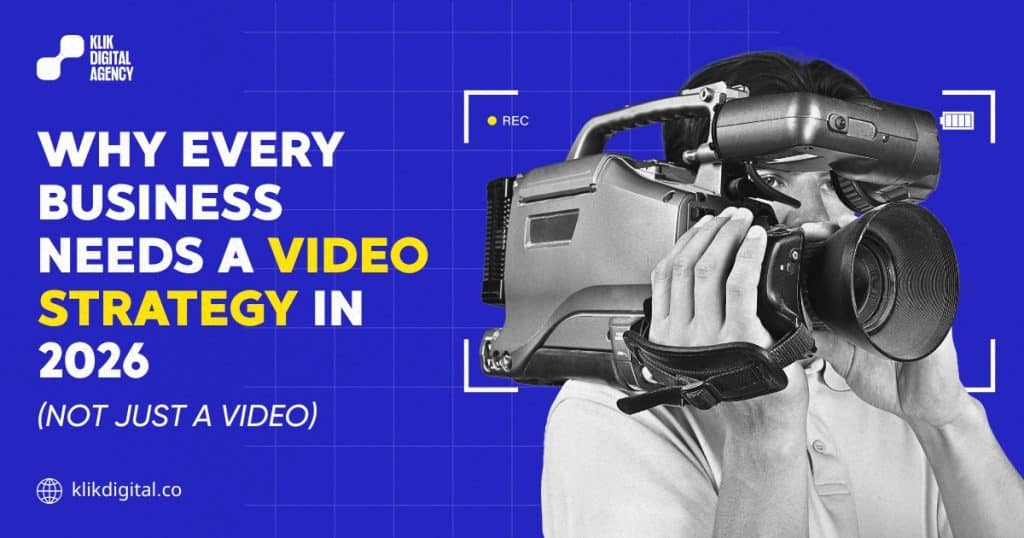Why Every Business Needs a Video Strategy in 2026 (Not Just a Video)
Subscribe to our newsletter
Keep up with the latest news in the digital marketing arena with Klik Digital. Subscribe Now!
Error: Contact form not found.

In 2026, the digital landscape moves at the speed of the fastest scroll. The days when simply uploading a professionally shot video guaranteed success are over. Today, audiences are scrolling faster, AI recommendation engines are smarter, and every platform—from YouTube to LinkedIn—demands a cohesive plan.
If your marketing strategy involves the occasional, spontaneous video, you’re missing the point. Video isn’t optional; it’s the strategic core of how consumers learn, engage, and make purchasing decisions. To succeed, businesses must shift from creating isolated content to building a unified, data-informed video marketing strategy that drives measurable results.
The Shift from “Having a Video” to “Having a Video Strategy”
Many businesses still treat video as checking the box: “We need a video for the homepage,” or “Let’s film a quick testimonial.” While production quality matters, distribution and context matter far more.
Why Random Video Posts No Longer Work in 2026:
- Platform Saturation: Content floods every channel. Without strategic planning, your video is immediately buried.
- Audience Sophistication: Users recognize generic, unplanned content and skip it. Tailoring content to the specific platform and user intent is a must.
- Algorithm Demand: Algorithms reward consistency and relevance. A single viral hit is less valuable than a steady stream of targeted content that consistently engages a niche audience.
A video marketing strategy is the blueprint for success. It details:
- What types of videos you create.
- Where you distribute your videos.
- How you measure video impact.
- How the content contributes to your ultimate business goals (leads, awareness, or sales).
This cohesive approach is what truly multiplies your ROI.
Why Video Dominates Digital Marketing in 2026
The data is clear: video isn’t just a trend. It’s the primary language of the internet.
- Engagement, Retention, and Purchase Influence: Studies consistently show that users retain information better when delivered via video. Furthermore, video content directly influences purchases. Many consumers cite video as key to their decision-making process.
- The Impact of Short-Form Video: Platforms like TikTok, YouTube Shorts, and Instagram Reels have accelerated consumption. Brands must master the art of the 7-to-60-second video to capture attention quickly and guide users to longer-form content or conversion points.
- The Role of Video in SEO and SERP Features: Google and other search engines prioritize rich media. Having videos embedded on your site that are properly optimized and structured increases the chance of securing SERP features (Search Engine Results Page), dominating organic search, and significantly boosting dwell time.

Common Mistakes Businesses Still Make with Video
Even businesses that invest heavily in production often fail because they overlook the strategic side of video marketing.
- Treating Video as a One-Time Campaign: Potential buyers quickly forget a single, expensive brand video. Success requires a video content strategy focused on continuous production and iterative improvement across all stages of the customer journey.
- Ignoring Optimization (Captions, Metadata, CTAs): Failing to add comprehensive titles, tags, descriptions, and closed captions (a non-negotiable for accessibility and SEO) means your video is essentially invisible. Treat video with the same SEO rigor as a blog post.
- Posting Without Performance Tracking: If you can’t measure it, you can’t improve it. Tracking views alone isn’t enough. You must monitor drop-off rates, click-through rates (CTR) on embedded calls-to-action (CTAs), and conversion attribution.
Building a True Video Strategy — Our Framework
Klik Digital bridges creativity and data, helping businesses move from one-off content pieces to cohesive, performance-driven video ecosystems that capture attention and strengthen brand trust. Here is our structured framework to transform your video ideas into a performance engine.
Step 1: Define Purpose and KPIs
Before recording anything, identify the desired outcome. Are you aiming for brand awareness (measured by impressions and reach), leads (measured by form submissions), or conversion (measured by sales attribution)? Clear, measurable KPIs are the foundation of your strategy.
Step 2: Align Video Types with Funnel Stages
Different videos serve different purposes:
- Awareness (Top-of-Funnel): Short-form hooks, quick tips, or entertaining explainers.
- Education (Mid-Funnel): Webinars, detailed product demos, or “how-to” guides.
- Retention/Conversion (Bottom-of-Funnel): Client testimonials, case studies, or personalized offers.
Step 3: Optimize for Every Platform
Every platform has its own rules:
- YouTube: Focus on long-term search visibility, strong thumbnails, and detailed descriptions.
- LinkedIn: Emphasize thought leadership, professional tips, and text overlays.
- TikTok/Reels: Prioritize rapid engagement, vertical format, and trending audio.
Step 4: Integrate SEO, Analytics, and Paid Campaigns
Your videos shouldn’t live in isolation. Integrate them into your existing digital marketing trends 2026 strategy. Use analytics to inform which videos to boost with paid media and ensure video titles are optimized with target keywords.
Step 5: Repurpose and Scale Through Data Insights
Analyze which videos perform best and why. Can you turn a 15-minute webinar into five short-form clips? Can you update an old testimonial with new stats? Repurposing content maximizes efficiency and scales your output.
How Video Strengthens SEO and AI Visibility
In the age of smart search and AI, video is a signal of quality and relevance.
- How videos improve dwell time and brand authority: When users click on your result and spend several minutes watching an embedded video, Google interprets this as a high-quality, relevant experience. This increased dwell time boosts your overall search ranking and strengthens your brand authority.
- Schema markup and structured data for AI and search engines: Using video schema markup helps search engines accurately categorize your video content, allowing it to appear directly in relevant video carousels and answer boxes. This is essential as AI models increasingly rely on structured data to provide summarized answers.
- Why AI search engines prioritize multimedia-rich results: Future search models powered by AI are moving beyond simple text. They seek a comprehensive answer, and the inclusion of high-quality multimedia—especially video—is increasingly seen as necessary to deliver a complete user experience.

Future-Proofing: What’s Next for Video in 2026 and Beyond
The video landscape will continue to evolve rapidly. Brands must be ready to adapt.
- Interactive and Shoppable Video Content: The ability for users to click directly within a video to learn more or purchase a product will become standard, blurring the line between content and commerce.
- Personalized, AI-Driven Video Experiences: Expect more tools that allow brands to tailor video content dynamically to the individual viewer based on their demographics or browsing history.
- Why Adaptability Will Define High-Performing Brands: The ability to quickly experiment with new formats (e.g., vertical vs. horizontal, short vs. long) and rapidly adjust based on performance data will be the hallmark of the most successful business video marketing teams.
Our Approach to Video Marketing in 2026
Klik Digital combines creative production with deep expertise in SEO, analytics, and strategy. We help you plan distribution across all channels, meticulously measure performance, and use those insights to iterate and improve. This disciplined, data-driven approach is the key to turning video into a reliable, measurable asset. We focus on measurable success, demonstrating how our strategies lead to tangible results like increased engagement, higher conversion rates, and lower bounce rates.
Turn your video ideas into a winning strategy – schedule your 2026 video strategy session with Klik Digital today to start building a measurable, impactful video ecosystem.
…………………………………………………………………………………………………..
FAQ

What’s the difference between video marketing and a video strategy?
Video marketing uses video content, like uploading a product demo. A video strategy is the comprehensive plan that dictates why you create specific videos, where you post them, and how you measure their success against your business goals.
How often should businesses create video content?
Consistency is key, and while the frequency varies by resource, a successful strategy emphasizes a regular, steady cadence over sporadic efforts. Quality and relevance to your audience should always take priority over sheer volume.
What types of videos work best in 2026?
The highest-performing videos are typically short-form hooks (under 60 seconds), educational “explainer” content, and authentic, raw client testimonials. Videos that address specific user pain points or answer common search questions perform exceptionally well.
How can Klik help businesses plan and execute a video strategy?
Klik Digital provides a comprehensive service, starting with a strategic audit and defining clear KPIs. We then manage production, develop the distribution plan, and use continuous analytics to ensure your video assets deliver optimal ROI.








